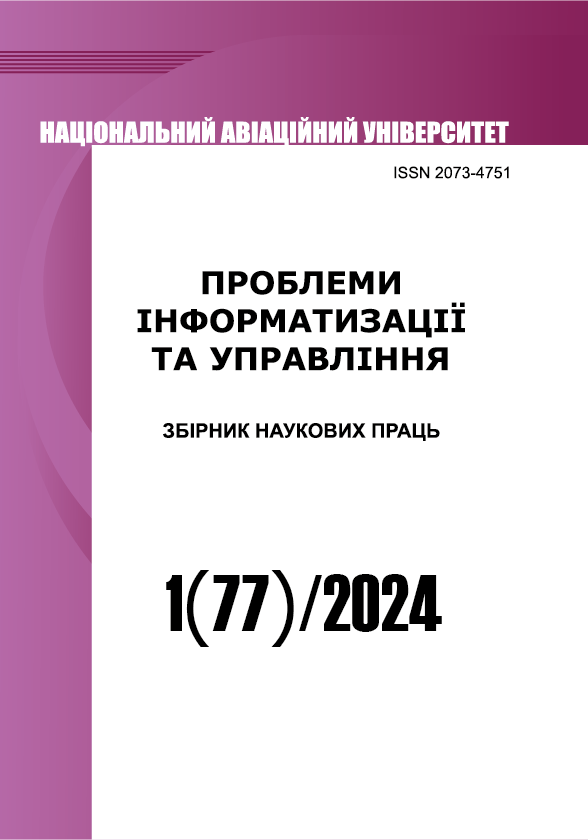Протоколи електронного голосування на основі криптографічної схеми "сліпого підпису" і біометричної автентифікації
DOI:
https://doi.org/10.18372/2073-4751.77.18656Ключові слова:
електронне голосування, криптографічні протоколи, підпис наосліп, біометрична автентифікаціяАнотація
В роботі проведено аналіз вимог до процедури електронного голосування і визначені деякі проблеми, які виникають при реалізації схем проведення виборів. Незважаючи на велику кількість існуючих схем проведення електронного голосування, що використовують різноманітні криптографічні методи, залишаються недоліки і вразливості, що потребують особливої уваги. Однією з таких проблем є запобігання продажу голосів. За основу вибрано один з найдосконаліших методів проведення голосування, а саме протокол Хе-Су, оскільки він задовольняє майже усім вимогам, що пред’являються до процесу електронних виборів. У роботі пропонується застосовувати криптографічні методи в комбінації з біометричною автентифікацією для часткового вирішення проблеми торгівлі голосами. Запропонований алгоритм проведення виборів ґрунтується на протоколі Хе-Су, що використовує гомоморфність криптографічної системи RSA процедуру сліпого підпису. Введення в алгоритм процедури біометричної автентифікації зменшує на нашу думку ймовірність продажу голосів недоброчесними виборцями, оскільки це стає складно зробити без фізичної присутності. Найбільш зручним видається біометрія відбитку пальця і використання мобільного застосунку, біометричний вхід у який авторизує організатор виборів.
Посилання
Schneier B. Applied Cryptography. Protocols, Algorithms, and Source Code in C. 2nd ed. New York : John Wiley & Sons, Inc., 1996. 784 p.
Brassard G., Crepeau C., Robert J.-M. All-or-Nothing Disclosure of Secrets. Lecture Notes in Computer Science. Vol. 263. Advances in Cryptology - CRYPTO '86. Proceedings / ed. by A. M. Odlyzko. Berlin, 1987. P. 234–238.
Heliosvoting project. URL: https://heliosvoting.org/.
Cortier V., Gaudry P., Glondu S. Features and usage of Belenios in 2022. Electronic Voting : proceedings of the 7th International Joint Conference, E-Vote-ID 2022, Bregenz, Austria, 4–7 October, 2022 / University of Tartu Press .Tartu, 2022. P. 53–56.
Chaum D. Blinding for unticipated signature. Lecture Notes in Computer Science. Vol. 304. Advances in Cryptology – EUROCRYPT '87. Workshop on the Theory and Application of Cryptographic Techniques, Amsterdam, The Netherlands, April 13-15, 1987. Proceedings / ed. by D. Chaum, W. L. Price. Berlin, 1988. P. 227–233.
Scantegrity. URL: http://www.scantegrity.org/
He Q., Su Z. A New Practical Secure e-Voting Scheme. IFIP/SEC’98 : proceedings of the 14th International Information Security Conference, Vienna/Budapest, Austria/Hungary, 31 August-4 September, 1998 / Austrian Computer Society. 1998. P.196–205.
Yang C.-H., Su P.-C., Su T.-C.. A novel electronic voting mechanism based on Blockchain technology. KSII Transactions on Internet and Information Systems. Vol. 17, no. 10. P. 2862–2882.
Fujioka A., Okamoto., Ohta K. A practical secret voting scheme for large scale elections. Lecture Notes in Computer Science. Vol. 718. Advances in Cryptology - AUSCRYPT '92. Workshop on the Theory and Application of Cryptographic Techniques, Gold Coast, Queensland, Australia, December 13-16, 1992. Proceedings / ed. by J. Seberry, Y. Zheng. Berlin, 1993. P. 244–251.
Cranor L., Cytron R. K. Sensus: A Security-Conscious Electronic Polling System for the Internet. 30th Hawaii International Conference on System Sciences (HICSS) : Volume 3: Information System Track-Organizational Systems and Technology, Maui, HI, USA, 3–6 January, 1997 / IEEE. Los Alamitos, 1997. P. 561–570.
Kakkad V., Patel M., Shah M. Biometric authentication and image encryption for image security in cloud framework. Multiscale and Multidisciplinary Modeling, Experiments and Design. 2019. Vol. 2. P. 233–248.
Gardham D., Manulis M., Drăgan C. C. Biometric-authenticated searchable encryption. Lecture Notes in Computer Science. Vol. 12147. Applied Cryptography and Network Security. 18th International Conference, ACNS 2020, Rome, Italy, October 19–22, 2020, Proceedings, Part II / ed. by M. Conti et al. Cham, 2020. P. 40–61.
Pawade D. et al. Secure online voting system using biometric and blockchain. Advances in Intelligent Systems and Computing. Vol. 1042. Data Management, Analytics and Innovation. Proceedings of ICDMAI 2019, Volume 1 / ed. by N. Sharma, A. Chakrabarti, V. E. Balas. Singapore, 2020. P. 93–110.
Chang Y.-J., Zhang W., Chen T. Biometrics Based Cryptographic Key Generation. 2004 IEEE Conference on Multimedia and Expo : proceedings, Taipei, Taiwan, 27–30 June 2004 / IEEE, 2005. P. 2203–2206.
##submission.downloads##
Опубліковано
Номер
Розділ
Ліцензія
Автори, які публікуються у цьому журналі, погоджуються з наступними умовами:- Автори залишають за собою право на авторство своєї роботи та передають журналу право першої публікації цієї роботи на умовах ліцензії Creative Commons Attribution License, котра дозволяє іншим особам вільно розповсюджувати опубліковану роботу з обов'язковим посиланням на авторів оригінальної роботи та першу публікацію роботи у цьому журналі.
- Автори мають право укладати самостійні додаткові угоди щодо неексклюзивного розповсюдження роботи у тому вигляді, в якому вона була опублікована цим журналом (наприклад, розміщувати роботу в електронному сховищі установи або публікувати у складі монографії), за умови збереження посилання на першу публікацію роботи у цьому журналі.
- Політика журналу дозволяє і заохочує розміщення авторами в мережі Інтернет (наприклад, у сховищах установ або на особистих веб-сайтах) рукопису роботи, як до подання цього рукопису до редакції, так і під час його редакційного опрацювання, оскільки це сприяє виникненню продуктивної наукової дискусії та позитивно позначається на оперативності та динаміці цитування опублікованої роботи (див. The Effect of Open Access).


